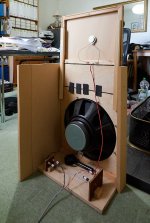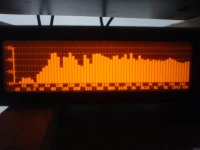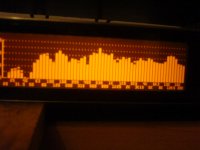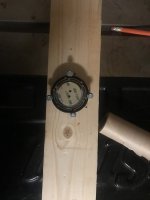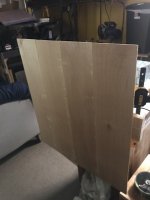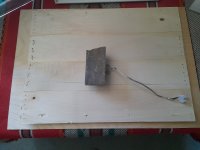Eric.
I don't know if this was just a throw away comment.
It should be mounted with a mostly fixed perimeter, as anything should.
maybe this panel should be clamped ,to try and fix its problems.
but if a free floating panel is designed correctly in the first place ,it should not need any clamping .
to prove my point, here is a plot of the low quality 70grade eps panel I have just put together, very simple and easy and very cheap to make.
The first picture is with The peak at about 13k .
The second is with this peak sorted.
Clamping depends on the panel used and if it has a poor performance.
If I clamped this panel in any way it's sound would be totally destroyed.
All my panels are designed without clamping, except my old full range very rigidly mounted ply panel.
If it doesn't need fixing ,don't clamp it.
Steve.
Christian.
In this post I removed the strong peak at 13k.
But one of the unexpected benefits of this is the dips either side of the peak are reduced and extended for a flatter response.
This method is only for the EPS,
I'm sure I did post this technique but it is like trying to find a needle in a haystack.
When I get time I will explain (grandchildren are imminent) , the low grade I just made will probably not benefit from this as it does not reach up high enough, but who knows?
It might benefit in other ways.
Steve.
They look like this. They are very much a prototype and somewhat lashed together using spare bits of MDF. The bass drivers are going into H frames, and the panels are are going to have a rather more elegant support system.Is this a variation on the OB H-frame woofers?
I battle to visualise it.
Attachments
I had some friends round yesterday for a music and hifi evening. The speakers were my OB bass / DML mid-top hybrids with a miniDSP serving as active crossover and driver/room EQ.
The chaps were blown away by the quality of the midrange and low to mid treble, with Miles Davis's Kind of Blue being the highlight. Using separate amplification for each channel helps a lot with separation (one of the qualities commented on more than once. There were two areas of weakness, lower bass weight and upper treble 'air'.
The former may be a consequence of the acrylic turntable mat I was using. Switching to something like a Funk Achromat may help. The latter may be partly a result of the high frequency performance of the AT VM95E cartridge. This does to tend to fall off above 16khz. The microline stylus should help here. I'd probably go moving coil if I didn't have a tendency to mangle styli with little accidents.
I'm certainly not as aware of lack of bass weight with CD as I am with vinyl.
Anyway, the bass drivers, as previously mentioned, are going into H frames which will extend the lower bass. Currently it's flat to 35hz and about 4db down at 30hz. The H frame should extend the flat part down to 30hz or maybe lower. The Fs of the driver is 25hz.
The chaps were blown away by the quality of the midrange and low to mid treble, with Miles Davis's Kind of Blue being the highlight. Using separate amplification for each channel helps a lot with separation (one of the qualities commented on more than once. There were two areas of weakness, lower bass weight and upper treble 'air'.
The former may be a consequence of the acrylic turntable mat I was using. Switching to something like a Funk Achromat may help. The latter may be partly a result of the high frequency performance of the AT VM95E cartridge. This does to tend to fall off above 16khz. The microline stylus should help here. I'd probably go moving coil if I didn't have a tendency to mangle styli with little accidents.
I'm certainly not as aware of lack of bass weight with CD as I am with vinyl.
Anyway, the bass drivers, as previously mentioned, are going into H frames which will extend the lower bass. Currently it's flat to 35hz and about 4db down at 30hz. The H frame should extend the flat part down to 30hz or maybe lower. The Fs of the driver is 25hz.
Here is an interesting site for who is interested in the physics of musical instruments... or DML or more simply searching for vulgarization : Euphonics The science of musical instruments. I like the writing style.
Christian
Christian
Andre said:These exciters have a tapped hole in the back of the magnet that will accept a threaded rod to be fastened to a brace for the sole intention of supporting the magnet.
I didn't notice that until you pointed it out. What do you use with it? I don't see any supporting hardware that screws into there on the parts express website.
Veleric said:And I also typically add some foam in between, but only to give the mounting a bit of compliance so that if the panel or spine warps a bit
What's your method for attaching the exciter to the spine? If you have foam in between I take it you're not using epoxy...
Also, how thin would you go on the wood panel? I discarded wood after my initial testing with the 6w exciters, But over the last couple days from other experimenting I've come to realize I didn't test properly, didn't have the exciter attached to the panel tightly enough. Hopefully tomorrow I can try a wood panel with the 6w.
I'm not quite sure how to answer this.What do you use with it?
ermmm... You use a threaded rod with it to fasten it to a brace. Or use an M3 bolt through the brace, choose the length of the bolt according to the thickness of the brace.
I think the 30HESF exciter takes an M6 thread.
The specifications drawings for each exciter model from Dayton will tell you exactly what size the thread is.
Or you can use epoxy if you prefer. Or double sided tape. Or double sided foam tape. Or chewing gum. Just attach it to a support unless you don't mind rattling and distortioned sound.
Last edited:
Examples...The specifications drawings for each exciter model from Dayton will tell you exactly what size the thread is.
Keep in mind that some of the models with legs and feet might not have tapped threads on the back. Those are self-supporting via the adhesive feet.
Brace, attached to the frame, behind the exciter. Exciter mounted to the brace with an M3 bolt epoxied into a hole inside the brace.
Last edited:
Jmproject.
A 6watt exciter is going to struggle on a wood panel.
You could XO higher up to take some of the pressure off of the exciter , maybe 200hz or so.
But keep an eye on the exciter temperature when playing loud music, especially rock music , they will get hot, and could self destruct.
I would recommend EPS for this wattage exciter.
Steve.
A 6watt exciter is going to struggle on a wood panel.
You could XO higher up to take some of the pressure off of the exciter , maybe 200hz or so.
But keep an eye on the exciter temperature when playing loud music, especially rock music , they will get hot, and could self destruct.
I would recommend EPS for this wattage exciter.
Steve.
Christian.
Is it a certain material you are interested in , when it comes to coil area problems, as it would make a difference to the treatment.
There are various things that can be done.
It depends on the material and exciter being used, and if they give a full frequency response.
These pictures were taken from my NXT Rubbish posts, many years ago, and show the peak above 10k , this was done using average response plots, because of outside noise during the day.
This was on a vh grade EPS panel 40x40cm 10mm.
I still have one untouched panel left.
The second picture shows the peak has been removed and the slight levelling of the response above and below the peak.
The amount varies depending on the panel and exciter.
You have to adjust this while watching the response in real time, to see if you are doing it correctly, you cannot just slap it on and hope for the best, as you will probably just make it worse.
Steve.
Is it a certain material you are interested in , when it comes to coil area problems, as it would make a difference to the treatment.
There are various things that can be done.
It depends on the material and exciter being used, and if they give a full frequency response.
These pictures were taken from my NXT Rubbish posts, many years ago, and show the peak above 10k , this was done using average response plots, because of outside noise during the day.
This was on a vh grade EPS panel 40x40cm 10mm.
I still have one untouched panel left.
The second picture shows the peak has been removed and the slight levelling of the response above and below the peak.
The amount varies depending on the panel and exciter.
You have to adjust this while watching the response in real time, to see if you are doing it correctly, you cannot just slap it on and hope for the best, as you will probably just make it worse.
Steve.
Attachments
jm,What's your method for attaching the exciter to the spine? If you have foam in between I take it you're not using epoxy...
The foams I use have adhesive on one side or both. If it has adhesive on only one side, I'll use double sided tape on the other side. The adhesive on one side of the foam gets attached to the back of the exciter, and the adhesive on the other side gets attached to the spine.
Eric
Hello Steve,Christian.
Is it a certain material you are interested in , when it comes to coil area problems, as it would make a difference to the treatment.
If you refer to my post 9400, the question is about EPS HF extension and the way you deal with this problem according to the EPS density.
Christian
Christian.
As you can see in post 9410 the vh grade EPS has no problem with HF extension.
Is it the getting rid of the 10k ish peak you are interested in.
Steve.
As you can see in post 9410 the vh grade EPS has no problem with HF extension.
Is it the getting rid of the 10k ish peak you are interested in.
Steve.
Thanks Andre. The DAEX32EP-4, which I have, definitely have those threaded holes, but it isn't documented on that spec sheet like yours are. 3mm has to be close so I'll grab some at the hardware store next time and try. I have a few bolts that are close but not quite. It's just surprising that parts express doesn't make that clear. even for yours, you shouldn't have to read a spec sheet and then go hunting for hardware for basic setup.
I contacted parts express to see what they say. But a tiny single hole is going to be difficult to work with either way. For now I've got 4 construction with flat heads securing it to the wood and I think it will work.
jm,
I don't quite understand why the single hole is difficult to work with. And what do you mean about the four flaheads? I can't imagine where you would have put four screws. Can you explain, or share a picture?
Eric
I don't quite understand why the single hole is difficult to work with. And what do you mean about the four flaheads? I can't imagine where you would have put four screws. Can you explain, or share a picture?
Eric
Christian
I Just weighed my vh grade EPS 40x40x 1 cm panel it was 58g, this comes to I believe 36.25 kg/m3 , I never thought it was that high !
They just sent me samples with no details of the grades or which were which ?
anyway I just presumed that it was the vh grade.
Steve.
I Just weighed my vh grade EPS 40x40x 1 cm panel it was 58g, this comes to I believe 36.25 kg/m3 , I never thought it was that high !
They just sent me samples with no details of the grades or which were which ?
anyway I just presumed that it was the vh grade.
Steve.
Hello Steve,I Just weighed my vh grade EPS 40x40x 1 cm panel it was 58g, this comes to I believe 36.25 kg/m3 , I never thought it was that high !
Pretty high yes. Is it with or without coating?
Let suppose without coating
If I use the heuristic from post #7207, 36kg/m³, the Young modulus is about 12MPa
So for a 10mm thickness, the areal mass is µ=0.36kg/m² and the bending stiffness is B = 1Nm.
So B/µ = 2.8, T=B/µ³= 21 (good value for efficiency)
See the blue cross in the chart.
So a little coating might help to reach HF loosing a bit in efficiency (orange arrow)
An alternative would have been the same material thicker like 12mm to move it in the green arrow direction using probably less coating.
Of course all of that is assumption. The measurement of the bending stiffness or the real Young modulus would help.
My current opinion with EPS is to get it in high density (let say 25 to 36kg/m³) in 25mm thick, measure its characteristics and then reduce its thickness to reach the target. The role of the coating is easy to see on the mass, on the bending stiffness, less known. Some samples are needed before doing the final panel.
Last edited:
jm,
I don't quite understand why the single hole is difficult to work with. And what do you mean about the four flaheads? I can't imagine where you would have put four screws. Can you explain, or share a picture?
Eric
To start with, for my model, it's undocumented, so I can get some 3mm machine screws but it's a guess. Then it doesn't look very deep, and now you have a single point of failure for coming loose. My screw solution (for now) attached.
-----
In general I've done several tests over the last few days. Several days ago I built a frame/spine for my little DAEX19CT-4 5w. Granted, the coin size is probably not the best test case for the spine theory. It was with a 7 x 11ish piece of 1" xps. I had a control of the same size with another 5w. They did about the same, the free-floater was a tad brighter I think. I tried out that DB phone app to help with the testing and that was close. Granted, my execution on the frame may have not been great. Then, I resawed 2/3s of the free-floater 7x11 off down to about 1/3 inch. Okay, that made a huge difference. The biggest difference the DB app picked up was the lows, would register down to 140 and even below 100. What was audible to me was it captured that same magical 3d quality that my initial cardboard boxes had. I just stood it up on one end with a couple of loose wood pieces keep it up. It was vibrating like crazy. I also have these old studio monitors that can be wired bi-amp, so I just wired the tweeter and in terms of any kind of output, the little Daytons win. I can't say about evenness across all high frequencies; these are just crude tests and I don't know what to look for anyway.
So I've thought, maybe these little guys can be tweeters for my system? I've got some crossovers on the way for both high and low to test different scenarios. Preliminary tests without XO, however, leave me unsure. they sound super bright compared to my 24" panels, and put out way more HF, but, I spent a lot of time trying to mix it in and I'm not convinced it makes the sound better. We will see with a crossover.
Another test this morning was I resawed some alder and glued up a 20x21" panel that's about 3.5mm thick on average. It sounded good but the xps is better, and louder. I could get it down to 2mm probably and it will still be stable enough, but I'm not convinced it will match the XPS. Of course, there's always the tradeoff between brilliance and stability. Maybe at higher volume levels the wood comes through.
Oh, finally, I thought that thinner XPS sounded so cool that I cut a 8 x 17" rectangle of XPS and resawed about 7mm from the front and also the back to have a pair. Not sure the glue job took but will fix that tomorrow and try them if so.
Attachments
Christian.
The only reason I remove the hard melted surface of the higher grades ( densities )is that it sounds bad.
The pva is a far better sounding surface material, not only that , but once all the water has evaporated you are only left with a trace of pva left on the panel, not a thick heavy coating.
when you sand off the hard eps coating you are left with a fluffy soft surface, which the highly thinned pva soaks into , and makes rigid.
You can if you want, use a thicker undiluted coating of pva if you wish, but I prefer to keep the EPS panel as light as possible.
The lower density EPS does not seem to have the hard surface of the higher densities, so sanding is not necessary.
I do like the sound of the lower density EPS ,so I need to sort out which I like best.
Without a hard skin EPS is very floppy.
I have used pva as surfaces on my card and veneer panels also, it seems to give just the right amount of flex to the panels, not too rigid or too heavy.
Steve.
The only reason I remove the hard melted surface of the higher grades ( densities )is that it sounds bad.
The pva is a far better sounding surface material, not only that , but once all the water has evaporated you are only left with a trace of pva left on the panel, not a thick heavy coating.
when you sand off the hard eps coating you are left with a fluffy soft surface, which the highly thinned pva soaks into , and makes rigid.
You can if you want, use a thicker undiluted coating of pva if you wish, but I prefer to keep the EPS panel as light as possible.
The lower density EPS does not seem to have the hard surface of the higher densities, so sanding is not necessary.
I do like the sound of the lower density EPS ,so I need to sort out which I like best.
Without a hard skin EPS is very floppy.
I have used pva as surfaces on my card and veneer panels also, it seems to give just the right amount of flex to the panels, not too rigid or too heavy.
Steve.
- Home
- Loudspeakers
- Full Range
- A Study of DMLs as a Full Range Speaker
